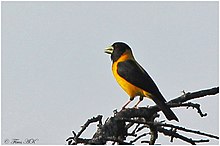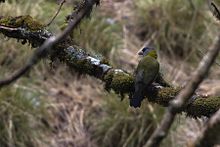45:
94:
31:
316:
69:
352:. It also may occur during the summer in dwarf juniper above the tree line in the mountains. Pairs or small parties usually perch near the tops of tall trees but forage often in lower vegetation or even on the ground. The collared grosbeak flies in tight flocks in a fast, direct but sometimes undulating flying style. The breeding behavior of this species is unknown. The grosbeak feeds on a variety of
339:
The collared grosbeak ranges from fairly common to scarce within its range. The species summers and breeds at an elevation of 2,700 to 4,200 m (8,900 to 13,800 ft). It engages in altitudinal movements, by winter traveling to as low as 1,800 m (5,900 ft) or even to 1,060 m
311:
is 2.6 to 2.9 cm (1.0 to 1.1 in). Adult males are glossy black on the head, upper-wings and tail. Contrasting with the black head, the collar is an earthy brownish color. The rest of the male's plumage is a rich, deep yellow. The female is olive-green on back and yellowish below with no
295:, may rival it in size. The species can range in length from 22 to 24 cm (8.7 to 9.4 in). The body mass of two males was reportedly 69 and 72 g (2.4 and 2.5 oz), while a single female weighed 83 g (2.9 oz). Among standard measurements, the
331:. The male's song is a clear, loud and rising whistle consisting of five to six notes. The grosbeaks may utter a creaky groan in antagonistic interactions.
679:
731:
811:
44:
653:
692:
490:
697:
851:
409:
775:
846:
736:
836:
640:
821:
718:
543:
449:
93:
570:
841:
831:
826:
340:(3,480 ft). This grosbeak occurs in mixed and coniferous forests, commonly around stands of
684:
578:
505:
312:
black about the face. The juvenile birds are fairly similar in appearance to the adult female.
710:
198:
762:
770:
627:
583:
552:
380:). A variety of this tough plant life is plucked with the strong bill. It may also feed on
296:
557:
8:
244:
58:
426:
816:
88:
757:
601:
486:
405:
308:
788:
606:
444:
645:
593:
744:
723:
528:
365:
805:
705:
435:
78:
73:
30:
315:
349:
288:
240:
215:
749:
666:
537:
385:
369:
165:
783:
658:
377:
671:
357:
248:
175:
145:
105:
619:
499:
522:
268:
125:
632:
565:
291:
family, but several other species, including others in the genus
272:
260:
287:
The collared grosbeak may be the largest species in the diverse
381:
276:
252:
115:
614:
389:
373:
341:
264:
256:
236:
155:
418:
353:
304:
300:
135:
361:
345:
424:
404:
by Peter
Clement. Princeton University Press (1999).
251:, along with some adjoining regions. It is found in
243:. Its range encompasses the northern regions of the
485:by John B. Dunning Jr. (Editor). CRC Press (1992),
323:The flight call of this bird is a mellow but rapid
307:is 2.7 to 2.9 cm (1.1 to 1.1 in) and the
299:is 12.1 to 13.8 cm (4.8 to 5.4 in), the
450:10.2305/IUCN.UK.2016-3.RLTS.T22720693A94678448.en
803:
327:. It is also known to utter a sharp alarm call,
303:is 8.7 to 9.7 cm (3.4 to 3.8 in), the
473:by Craig Robson. New Holland Field Guides.
67:
43:
29:
471:Birds of South-East Asia (Field Guide to)
448:
314:
804:
504:
503:
812:IUCN Red List least concern species
436:IUCN Red List of Threatened Species
13:
476:
275:is mountainous deciduous or mixed
14:
863:
483:CRC Handbook of Avian Body Masses
92:
425:BirdLife International (2016).
464:
282:
1:
395:
7:
10:
868:
852:Taxa named by Edward Blyth
334:
319:John Gould's illustration.
512:
204:
197:
89:Scientific classification
87:
65:
56:
51:
42:
37:
28:
23:
443:: e.T22720693A94678448.
847:Birds described in 1855
837:Birds of Central China
320:
318:
822:Birds of North India
402:Finches and Sparrows
245:Indian Subcontinent
59:Conservation status
325:Pip-pip-pip-pip-uh
321:
235:) is a species of
24:Collared grosbeak
799:
798:
789:Mycerobas-affinis
758:Open Tree of Life
558:Mycerobas_affinis
544:Mycerobas affinis
514:Mycerobas affinis
506:Taxon identifiers
491:978-0-8493-4258-5
429:Mycerobas affinis
232:Mycerobas affinis
227:collared grosbeak
223:
222:
208:Mycerobas affinis
82:
859:
792:
791:
779:
778:
766:
765:
753:
752:
740:
739:
727:
726:
724:NHMSYS0020789002
714:
713:
701:
700:
688:
687:
675:
674:
662:
661:
649:
648:
636:
635:
623:
622:
610:
609:
597:
596:
587:
586:
574:
573:
571:F7B5C3864E07BFCA
561:
560:
548:
547:
546:
533:
532:
531:
501:
500:
494:
480:
474:
468:
462:
461:
459:
457:
452:
422:
210:
97:
96:
76:
71:
70:
47:
33:
21:
20:
867:
866:
862:
861:
860:
858:
857:
856:
842:Birds of Yunnan
832:Birds of Bhutan
802:
801:
800:
795:
787:
782:
774:
769:
761:
756:
748:
745:Observation.org
743:
735:
730:
722:
717:
709:
704:
696:
691:
683:
678:
670:
665:
657:
652:
644:
639:
631:
626:
618:
613:
605:
600:
592:
590:
582:
577:
569:
564:
556:
551:
542:
541:
536:
527:
526:
521:
508:
498:
497:
481:
477:
469:
465:
455:
453:
423:
419:
398:
337:
285:
219:
212:
206:
193:
190:M. affinis
91:
83:
72:
68:
61:
17:
16:Species of bird
12:
11:
5:
865:
855:
854:
849:
844:
839:
834:
829:
827:Birds of Nepal
824:
819:
814:
797:
796:
794:
793:
780:
767:
754:
741:
728:
715:
702:
689:
676:
663:
650:
637:
624:
611:
598:
588:
575:
562:
549:
534:
518:
516:
510:
509:
496:
495:
475:
463:
416:
415:
414:
413:
410:978-0691048789
397:
394:
336:
333:
284:
281:
271:. Its natural
239:in the family
221:
220:
213:
202:
201:
195:
194:
187:
185:
181:
180:
173:
169:
168:
163:
159:
158:
153:
149:
148:
143:
139:
138:
133:
129:
128:
123:
119:
118:
113:
109:
108:
103:
99:
98:
85:
84:
66:
63:
62:
57:
54:
53:
49:
48:
40:
39:
35:
34:
26:
25:
15:
9:
6:
4:
3:
2:
864:
853:
850:
848:
845:
843:
840:
838:
835:
833:
830:
828:
825:
823:
820:
818:
815:
813:
810:
809:
807:
790:
785:
781:
777:
772:
768:
764:
759:
755:
751:
746:
742:
738:
733:
729:
725:
720:
716:
712:
707:
703:
699:
694:
690:
686:
681:
677:
673:
668:
664:
660:
655:
651:
647:
642:
638:
634:
629:
625:
621:
616:
612:
608:
603:
599:
595:
589:
585:
580:
576:
572:
567:
563:
559:
554:
550:
545:
539:
535:
530:
524:
520:
519:
517:
515:
511:
507:
502:
492:
488:
484:
479:
472:
467:
451:
446:
442:
438:
437:
432:
430:
421:
417:
411:
407:
403:
400:
399:
393:
391:
388:, as well as
387:
383:
379:
375:
371:
367:
363:
359:
355:
351:
347:
343:
332:
330:
326:
317:
313:
310:
306:
302:
298:
294:
290:
280:
278:
274:
270:
266:
262:
258:
254:
250:
247:, mainly the
246:
242:
238:
234:
233:
228:
217:
211:
209:
203:
200:
199:Binomial name
196:
192:
191:
186:
183:
182:
179:
178:
174:
171:
170:
167:
164:
161:
160:
157:
154:
151:
150:
147:
146:Passeriformes
144:
141:
140:
137:
134:
131:
130:
127:
124:
121:
120:
117:
114:
111:
110:
107:
104:
101:
100:
95:
90:
86:
80:
75:
74:Least Concern
64:
60:
55:
50:
46:
41:
36:
32:
27:
22:
19:
513:
482:
478:
470:
466:
454:. Retrieved
440:
434:
428:
420:
401:
386:caterpillars
350:rhododendron
338:
328:
324:
322:
292:
286:
241:Fringillidae
231:
230:
226:
224:
207:
205:
189:
188:
176:
156:Fringillidae
18:
667:iNaturalist
538:Wikispecies
456:11 November
378:crab apples
376:(including
360:as well as
283:Description
166:Carduelinae
162:Subfamily:
806:Categories
784:Xeno-canto
396:References
358:pine cones
297:wing chord
817:Mycerobas
384:, mainly
293:Mycerobas
249:Himalayas
184:Species:
177:Mycerobas
112:Kingdom:
106:Eukaryota
711:22720693
685:10213672
633:45517665
584:22720693
579:BirdLife
529:Q1085277
523:Wikidata
269:Thailand
152:Family:
126:Chordata
122:Phylum:
116:Animalia
102:Domain:
79:IUCN 3.1
659:2494407
620:colgro1
594:colgro1
566:Avibase
382:insects
335:Ecology
277:forests
273:habitat
261:Myanmar
218:, 1855)
172:Genus:
142:Order:
132:Class:
77: (
52:Female
763:947027
737:175945
698:561275
641:EURING
489:
408:
390:snails
374:fruits
366:shoots
309:tarsus
253:Bhutan
776:11150
750:78349
680:IRMNG
672:10219
646:17120
615:eBird
607:6RSBN
591:BOW:
354:seeds
342:maple
289:finch
265:Nepal
257:India
237:finch
216:Blyth
38:Male
732:NCBI
706:IUCN
693:ITIS
654:GBIF
487:ISBN
458:2021
441:2016
406:ISBN
370:nuts
362:buds
356:and
329:kurr
305:bill
301:tail
267:and
225:The
136:Aves
771:TSA
719:NBN
628:EoL
602:CoL
553:ADW
445:doi
364:or
348:or
346:oak
808::
786::
773::
760::
747::
734::
721::
708::
695::
682::
669::
656::
643::
630::
617::
604::
581::
568::
555::
540::
525::
439:.
433:.
392:.
372:,
368:,
344:,
279:.
263:,
259:,
255:,
493:.
460:.
447::
431:"
427:"
412:.
229:(
214:(
81:)
Text is available under the Creative Commons Attribution-ShareAlike License. Additional terms may apply.

